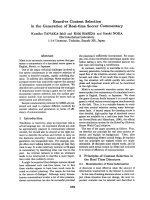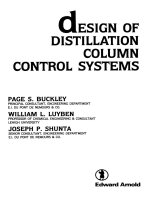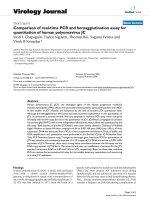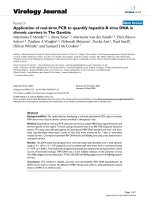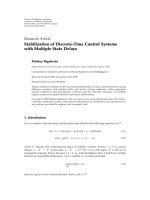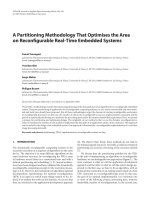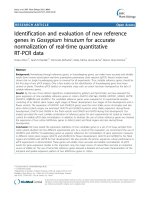Dynamic scheduling of real time control systems
Bạn đang xem bản rút gọn của tài liệu. Xem và tải ngay bản đầy đủ của tài liệu tại đây (523.84 KB, 92 trang )
DYNAMIC SCHEDULING OF REAL-TIME CONTROL SYSTEMS
QIAN LIN
A DISSERTATION SUBMITTED FOR
THE DEGREE OF MASTER OF ENGINEERING
DEPARTMENT OF MECHANICAL ENGINEERING
NATIONAL UNIVERSITY OF SINGAPORE
2004
Acknowledgements
Firstly, I would like to thank my two supervisors, Dr. Peter C. Y. Chen and Prof.
A. N. Poo, for their instructive guidance and constant personal encouragement
during every stage of this research. I greatly respect their inspiration, professional
dedication and scientific ethos.
I am also fortunate to meet so many talented fellows in the Control Laboratory,
who make the two years exciting and the experience worthwhile. Everybody has
been most helpful and friendly.
My gratitude also goes to Mr. C. S. Yee, Mrs. Ooi, Ms. Tshin and Mr. Zhang
for the helps on facility support in the laboratory so that the project may be
completed smoothly.
ii
Table of contents
Acknowledgements
ii
Summary
vi
1 Introduction
1.1 Problem definition . . . . . . . .
1.2 Motivation . . . . . . . . . . . . .
1.3 Methodology and result overview
1.4 Organization . . . . . . . . . . .
.
.
.
.
.
.
.
.
.
.
.
.
.
.
.
.
.
.
.
.
.
.
.
.
.
.
.
.
.
.
.
.
2 Background
2.1 Discrete control design . . . . . . . . . . . . . .
2.1.1 Discrete-time design . . . . . . . . . . .
2.1.2 Discretization of continuous-time design
2.1.3 Algorithm implementation . . . . . . . .
2.2 Task attributes . . . . . . . . . . . . . . . . . .
2.3 Real-time scheduling . . . . . . . . . . . . . . .
2.3.1 Scheduling algorithm . . . . . . . . . . .
2.3.2 Schedulability . . . . . . . . . . . . . . .
2.4 Flexible scheduling . . . . . . . . . . . . . . . .
3 Related Works
3.1 Control scheduling co-design
3.2 Control integral scheduling .
3.3 Feedback scheduling . . . .
3.4 QoS adaptation . . . . . . .
.
.
.
.
.
.
.
.
.
.
.
.
.
.
.
.
.
.
.
.
.
.
.
.
.
.
.
.
.
.
.
.
.
.
.
.
.
.
.
.
4 Aperiodic Sampling Based on Task Urgency
4.1 Performance index function . . . . . . . . . .
4.1.1 Performance change rate . . . . . . . .
4.2 Task urgency . . . . . . . . . . . . . . . . . .
4.2.1 On-line amplitude detection . . . . . .
4.3 Aperiodic sampling based on task urgency . .
4.3.1 Simulation example . . . . . . . . . . .
.
.
.
.
.
.
.
.
.
.
.
.
.
.
.
.
.
.
.
.
.
.
.
.
.
.
.
.
.
.
.
.
.
.
.
.
.
.
.
.
.
.
.
.
.
.
.
.
.
.
.
.
.
.
.
.
.
.
.
.
.
.
.
.
.
.
.
.
.
.
.
.
.
.
.
.
.
.
.
.
.
.
.
.
.
.
.
.
.
.
.
.
.
.
.
.
.
.
.
.
.
.
.
.
.
.
.
.
.
.
.
.
.
.
.
.
.
.
.
.
.
.
.
.
.
.
.
.
.
.
.
.
.
.
.
.
.
.
.
.
.
.
.
.
.
.
.
.
.
.
.
.
.
.
.
.
.
.
.
.
.
.
.
.
.
.
.
.
.
.
.
.
.
.
.
.
.
.
.
.
.
.
.
.
.
.
.
.
.
.
.
.
.
.
.
.
.
.
.
.
.
.
.
.
.
.
.
.
.
.
.
.
.
.
.
.
.
.
.
.
.
.
.
.
.
.
.
.
.
.
.
.
.
.
.
.
.
.
.
.
.
.
.
.
1
1
4
5
6
.
.
.
.
.
.
.
.
.
7
7
7
9
11
12
12
13
14
16
.
.
.
.
19
19
20
21
22
.
.
.
.
.
.
25
26
37
38
41
42
43
iii
4.4
Summary . . . . . . . . . . . . . . . . . . . . . . . . . . . . . . . . 45
5 Dynamic Scheduling
5.1 Scheduling algorithm . . . . . . . .
5.2 Implementation issues . . . . . . .
5.2.1 Sampling frequency bounds
5.2.2 FDPCR approximation . . .
5.3 Simulation example . . . . . . . . .
5.4 Results analysis . . . . . . . . . . .
.
.
.
.
.
.
.
.
.
.
.
.
.
.
.
.
.
.
.
.
.
.
.
.
.
.
.
.
.
.
.
.
.
.
.
.
.
.
.
.
.
.
.
.
.
.
.
.
.
.
.
.
.
.
.
.
.
.
.
.
.
.
.
.
.
.
.
.
.
.
.
.
.
.
.
.
.
.
.
.
.
.
.
.
.
.
.
.
.
.
.
.
.
.
.
.
.
.
.
.
.
.
.
.
.
.
.
.
47
47
50
50
51
51
56
6 Conclusions
58
References
60
Appendices
64
A Least Squares Approximation
65
B Source Code for Simulation
B.1 Simulation code for single-task systems . . . . . . . . .
B.1.1 Single task initial function . . . . . . . . . . . .
B.1.2 Single task control algorithm . . . . . . . . . . .
B.1.3 Single task on-line urgency computation . . . .
B.2 Simulation code for three-task systems . . . . . . . . .
B.2.1 Three control tasks initial function . . . . . . .
B.2.2 Control algorithm for task 1 and 3 . . . . . . .
B.2.3 Control algorithm for task 2 . . . . . . . . . . .
B.2.4 Multi-task system on-line urgency computation
B.2.5 Multi-task system CPU allocation . . . . . . . .
B.3 Kernel functions . . . . . . . . . . . . . . . . . . . . . .
68
68
68
69
70
71
71
72
73
74
74
75
.
.
.
.
.
.
.
.
.
.
.
.
.
.
.
.
.
.
.
.
.
.
.
.
.
.
.
.
.
.
.
.
.
.
.
.
.
.
.
.
.
.
.
.
.
.
.
.
.
.
.
.
.
.
.
.
.
.
.
.
.
.
.
.
.
.
.
.
.
.
.
.
.
.
.
.
.
iv
Summary
In a typical real-time digital control system, a microprocessor is often embedded
in the system to generate the control signal periodically. The number of such
computation per unit time is referred to as the sampling frequency. It is a known
fact that sampling frequency of a control system has direct effect on the system’s
performance. Normally higher sampling frequency leads to better performance.
However, a higher sampling frequency implies that more computational resources
are needed, which increases the workload of the computer. Therefore, in design
and implementation of digital control systems, there exists a trade-off between
performance of a system and computational resources required in order to achieve
such performance. In this thesis, we design the sampling frequencies by solving
this trade-off problem on-line. The objective is to optimize the overall control
system’s performance by allocating CPU time efficiently.
Studies on the trade-off between the task sampling frequency and system performance have been reported in the literature. In one approach (Seto et al., 1996),
a set of optimal task periods is chosen to minimize a given control cost function
under certain scheduling constraints. This optimization problem is based on the
convex function of control performance and sampling frequency. However, this offline approach to varying task period did not consider change in task urgency in
real-time. This approach was extended such that allocation of processor utilization
is made on-line with periodic adjustment (Shin and Meissner, 1999). The extended
approach uses a performance index to weight a task’s urgency to the system, and
v
consequently determines the optimal task periods. However, determination of the
coefficients in scaling the task urgency remains ad hoc.
In this thesis, a systematic way to evaluate the task urgency change in real-time
is developed. Based on this on-line task urgency, a dynamic scheduling algorithm
for on-line adjustment of task periods is proposed. An aperiodic sampling method
is employed in the dynamic scheduling algorithm to improve the efficiency of CPU
usage. Task periods are regarded as variables dependent on the urgency of the
tasks and system scheduling constraints. Simulation results are presented to compare our on-line dynamic scheduling algorithm with the off-line optimal designed
scheduling algorithm of (Seto et al., 1996). The simulation results show that with
on-line dynamic scheduling the system performance is improved.
vi
List of Figures
1.1
Signals in a computer control system. . . . . . . . . . . . . . . . . .
2.1
Illustration of the time relationship between deadline, response time,
and input-output latency for a control task. . . . . . . . . . . . . . 13
4.1
4.2
4.3
4.4
4.5
4.6
4.7
4.8
Performance index function with sampling frequency as variable. .
Performance index function with time as variable. . . . . . . . . .
Detailed performance index. . . . . . . . . . . . . . . . . . . . . .
Illustration of Jd (t, f ) definition. . . . . . . . . . . . . . . . . . . .
J (t, f ) with both time and sampling frequency as variables. . . .
PI function with both time and sampling frequency as variables. .
Control signal and sampling frequencies using aperiodic sampling.
Control output signal and CPU usage. . . . . . . . . . . . . . . .
.
.
.
.
.
.
.
.
28
29
30
31
33
34
46
46
5.1
5.2
5.3
5.4
Dynamical scheduling algorithm. . . . .
The three-task computer-control system.
The approximated r(f ). . . . . . . . . .
Outputs of three-task control system. . .
.
.
.
.
50
52
53
55
.
.
.
.
.
.
.
.
.
.
.
.
.
.
.
.
.
.
.
.
.
.
.
.
.
.
.
.
.
.
.
.
.
.
.
.
.
.
.
.
.
.
.
.
.
.
.
.
.
.
.
.
.
.
.
.
2
A.1 Jd curve approximation by LS. . . . . . . . . . . . . . . . . . . . . . 67
vii
List of Tables
1.1
Implementation of a real-time control system in loops . . . . . . . .
3
4.1
4.2
4.3
Data for J (t, f ) with respect to time and frequency variables. . . . 32
Approximation error for J (t, f ) function. . . . . . . . . . . . . . . . 36
Amplitude of the frequency components on-line computation . . . . 42
5.1
5.2
5.3
Dynamic scheduling algorithm implementation . . . . . . . . . . . . 49
parameters of the three control tasks. . . . . . . . . . . . . . . . . . 52
Comparison on the performance indices. . . . . . . . . . . . . . . . 55
A.1 Data for Jd (f ). . . . . . . . . . . . . . . . . . . . . . . . . . . . . . 66
A.2 Matlab code for solving Equation (A.5). . . . . . . . . . . . . . . . 67
viii
Chapter 1
Introduction
1.1
Problem definition
Computer control systems constitute a large part of all real-time systems. They
have been widely applied in industry ranging from flight control to micro-surgery.
A computer control system consists of two major parts: the physical system and
the computer system. The physical system includes the physical plants to be
controlled, sensors to provide information on the plants’ real time behavior, and
actuators to drive the physical plants. The computer system usually consists of
an embedded microcomputer, which is used to compute control commands for the
physical plants.
Due to the discrete nature of computer, a computer control system has to
sample the analog signals of the plants. An illustration of a computer control
system is given in Figure 1.1. In each period for each physical plant, an analog to
digital (A-D) converter transforms the continuous output signal y(t) into digital
signal y(k) that can be handled by computer. After the computer calculates the
control signal according to the control algorithm, the control signal is transformed
into continuous signal u(t) by a digital to analog (D-A) converter and fed to the
plant.
1
y(t)
u(t)
t
t
Plant n
u(t)
y(t)
Plant 1
Holder
sampler
D-A
Computer
u(k)
A-D
y(k)
u(k)
y(k)
t
t
Figure 1.1: Signals in a computer control system. The continuous signal y(t)
becomes the discrete signal y(k) through sampler; u(k) is converted as u(t) through
a holder with zero order.
The computation for control signal is implemented as a task that should be
executed by the computer at a fixed rate, which means that the controller requests
y(k) (shown in Figure 1.1) at equal intervals of time. The computation task is
modelled as a periodic task characterized by several attributes: the period of task
T , which equals to the sampling period; each task requires specific computational
time to execute the control algorithm once, denoted as e, where e < T ; each task
also has an associate deadline, denoted as D. The pseudo-code for a control loop
in a real-time system is shown as in Table 1.1.
In a real-time system, a computer controller is usually part of the system. The
computation resource is limited due to the expense and the physical space. All
2
Table 1.1: The implementation of a real-time control system in loops.
pseudo-code for a control loop
t = CurrentTime;
LOOP
AD-Conversion;
Control Algorithm Execution;
DA-Conversion;
t=t+T;
Wait till the next release time t;
END
physical systems being controlled requires attention from the computer and compete for the limited CPU resource. The computer can focus more attention on
the task of a particular plant and service it at a high frequency. This is helpful to
improve the performance of that plant. However, the other tasks serviced by the
same computer will then suffer for the insufficient attention from the computer
which can result in the degradation of the whole system’s performance. Hence,
there is a trade-off between system performance and required computation resource. In this thesis, we attempt to tackle the trade-off problem by allocating
CPU time dynamically to optimize the performance of digital control systems.
How a reasonable sampling frequency should be chosen is an important issue in
real-time computer control system design. A traditional controller requests y(k)
(see Figure 1.1) at equal intervals of time, and the requesting rate is decided by
trial-and-error testing and is ad hoc (Astrom and Wittenmark, 1985). This is
neither the fastest nor the best way to determine the sampling rate for a given
application, although it is probably the most common. Here we consider the online adaptation of sampling frequencies for the periodic tasks in real-time systems.
The sampling periods for tasks are regarded as variables, which depend on both
the resource constraints and the control performance. The key problem here is
how the optimal values for these sampling period variables are to be determined
3
dynamically to obtain the best control performance.
We consider the case in which the real-time system has only a single processor
with limited computing capacity, the task execution time has been well measured
and unchanged, and the task deadline equals to its period.
1.2
Motivation
Traditional real-time computer-controlled systems are designed in two separate
steps: controller design and real-time scheduling (Seto et al., 2001). Controller
design is primarily based on the continuous-time dynamics of the physical system
without considering the computational capacity of the controller. It assumes that
the computer platform used can cope with the deterministic, fixed sampling period as required in the implementation of the control system. The set of tasks
designed in this way may not be schedulable because of the limited available computing resources, and the unschedulable system will result in degraded control
performance. Even if the given tasks are schedulable, their overall performance
may not be optimal in the sense that they may fail to distribute the CPU resource
efficiently.
When there is insufficient computing resource for the real-time control computation, one may intuitively think of adding additional processors or replacing
the computer with a more powerful one. Both approaches could certainly solve
the problem, but they may be neither efficient nor economical. The reduction
of resource usage without degrading system performance is one of the challenges
in software issues that is well worth being addressed. On the other hand, even
when the computing resource is sufficient for scheduling the given set of tasks,
there is still the potential for improving the overall control system performance
by increasing the efficiency of CPU usage.
Hence, an understanding of both control task design and resource schedul-
4
ing is required for control applications where computing resource is limited. In
fact, resource schedulability is directly decided by the design of the control task.
Processor utilization of a periodic task can be changed by adjusting the task’s
execution time or task’s period. It is possible to use varying sampling intervals in
computing control signal, and a new control signal is calculated only when it is
necessary. Generally it is assumed that for a control task, the more the computing
resource is utilized, the better the control performance. However, when aperiodic sampling intervals are carefully adopted, the reduction in CPU utilization on
a control task may not necessarily result in degradation in control performance.
Consequently, CPU time can be saved and assigned to other tasks for their performance improvement. Hence, it is advantageous to consider the task sampling
period as a variable instead of a fixed value.
1.3
Methodology and result overview
In this thesis, task sampling frequencies are regarded as variables to be determined
with the objective of optimizing the overall system control performance while
keeping the system schedulable. In order to determine the optimal set of sampling
frequencies, an on-line dynamic scheduling algorithm is developed. This scheduling
algorithm is an extension of the traditional design by Seto et al. (1996). It is based
on the optimization of a performance index function, with the available CPU
resource allocated to the task, or tasks that will result in the highest improvement
to the performance index.
The well-known performance index (PI) function used in optimal control is
investigated and extended in this thesis. We developed this PI function as an
on-line function by considering time as an additional variable. The performance
index function then becomes more accurate.
We show that control systems have different on-line requirements on CPU
5
resource under different control states during the control process. For example,
Cervin (2000) considered a hybrid controller with two modes in the control tasks.
The control tasks are switched between a transient mode and a steady-state mode,
as the requirements on sampling frequency are quite different. The task period can
be longer when the control system is in the steady state and CPU time can then
be saved. We proposed task urgency to evaluate the task on-line requirements for
CPU time, and then developed a systematic way to detect the task on-line urgency
by signal analysis. We also designed an on-line dynamic scheduling algorithm for
on-line task period adjustment using the idea of giving more CPU time to more
important tasks dynamically. The results for single-task system simulation show
that sampling with task urgency can save computation resource without degrading
the control performance. The results for multi-task system simulation show that
the on-line dynamic scheduling algorithm can reduce the control output error as
compared with the traditional approach.
1.4
Organization
We investigate some related issues as background review in Chapter 2, in which
task attributes and deadline properties, fundamental scheduling algorithms and
control-scheduling integral design are reviewed. In Chapter 3, we give a thorough
literature review, and clarify the motivation of this work. In Chapter 4, the
performance index function is investigated. We introduce performance change rate
and task urgency, and then propose an aperiodic sampling approach to achieve
efficient CPU time utilization. In Chapter 5 we describe the dynamic scheduling
algorithm in detail. Simulation results are presented to verify the performance
improvement. We conclude in Chapter 6.
6
Chapter 2
Background
In this chapter, we present the background of computer control systems. In Section
1, we give an overview of discrete control system design and ad hoc rules to choose
sampling frequency. In Section 2, we investigate the task timing attributes. In
Section 3, we review the basic scheduling algorithm and the issue of computer
system schedulability. In Section 4 we discuss the techniques of flexible scheduling.
2.1
Discrete control design
There are two ways to implement computer-based control systems: continuoustime design of the controller followed by discretization, and direct discrete-time
design of the controller.
2.1.1
Discrete-time design
Discrete design considers only the values of the system inputs and outputs at the
sampling instants, from the point of view of the computer. A discrete model of
the continuous plant has to be derived before the discrete-time controller can be
designed. The sampling frequency in the discrete-time controller design has to be
determined in advance. The discretized control system is sensitive to varying of
7
sampling frequency. Any variation of sampling frequency during operation, for
example through an unintentional change in the system’s real-time clock, may
change the system’s dynamics significantly, perhaps even leading to instability.
Consider a continuous time-invariant system with the following description
dx
= Ax(t) + Bu(t),
dt
y(t) = Cx(t) + Du(t),
(2.1)
where x is the control signal, u is the step input, y is the output signal and A, B,
C, D are matrices.
The solution to the system Equation (2.1) is given by
x(t) = eA(t−tk ) x(tk ) +
t
tk
eA(t−s ) Bu(s )ds
= eA(t−tk ) x(tk ) +
t
tk
eA(t−s ) ds Bu(tk )
= eA(t−tk ) x(tk ) +
t−tk
0
(2.2)
eAs dsBu(tk )
= Φ(t, tk )x(tk ) + Γ(t, tk )u(tk ),
where
Φ(t, tk ) = eA(t−tk ) ,
Γ(t, tk ) =
t−tk
0
eAs dsB.
From this the values at t = tk+1 are given by
x(tk+1 ) = Φ(tk+1 , tk )x(tk ) + Γ(tk+1 , tk )u(tk ),
(2.3)
y(tk ) = Cx(tk ) + Du(tk ).
The expression above is valid both for periodic and aperiodic sampling. Usually
we assume periodic sampling with a fixed sampling period T. This leads to the
8
well-known discrete-time system description as follows
tk = k · T,
x[(k + 1)T ] = Φx(kT ) + Γu(kT ),
(2.4)
y(kT ) = Cx(kT ) + Du(kT ),
where
Φ = eAT ,
Γ=
T
0
eAs dsB.
The resulting system description is time-invariant. It only describes the system
at the sampling instants. Many discrete-time methods for controller design can
be applied, such as pole placement, and linear quadratic design.
The sampling intervals for discrete-time control system designs are normally
based on the desired frequency of the closed loop system. A rule of thumb to
decide the sampling interval for discrete-time control is that one should sample 4
to 10 times per rise time of the closed loop system, i.e.
Tr
≈ 4 ∼ 10,
T
(2.5)
where Tr denotes rise time, and T the sampling interval. This gives relatively long
sampling intervals compared with that obtained using the discretization-based
design.
2.1.2
Discretization of continuous-time design
The analog design idea is to design the controller in the continuous time domain,
and then approximate this design by fast sampling. Let us assume that a controller
has been designed in continuous time, and the close-loop transfer function is G(s).
The goal of computer control design is to approximate this design in such a way
that the discrete system GD (z) approximately equals to the continuous system
9
G(s). It is not necessary to employ any special discrete control design theory, but
has higher requirements on sampling. Several approximate methods have been
discussed by Katz (1981). The most straightforward way is to use a simple Euler
forward or backward approximation.
In the forward approximation, a derivative is replaced by its forward approximation:
dx(t)
x(t + T ) − x(t)
≈
.
dt
T
(2.6)
This is equivalent to replacing the Laplace operator s with (z − 1)/T in G(s),
where z denotes the z-operator in discrete control theory. In the backward approximation, the derivative is replaced by
x(t) − x(t − T )
dx(t)
≈
,
dt
T
(2.7)
which is equivalent to replacing the Laplace operator s with (z − 1)/zT .
The approximation generates various new phenomena which are not encountered in the continuous design. Compared with the continuous-time control signal,
the discrete-time control signal is delayed half of a sample period on the average.
This delay introduces a phase lag and a degradation on the closed-loop performance.
The major property required by the discretized system is the fidelity of the impulse and frequency response of the original analog system. This fidelity depends
on both the sampling rate and on the particular method of discretization. The
choice of the sampling frequency is therefore important. By lowering the sampling
rate, the fidelity and accuracy of the discrete filter are being impaired.
The choice of sampling rate depends on many factors. One way to choose this
is to use continuous-time arguments. The discretized system can be approximated
by a hold circuit, followed by the continuous-time system. A rule of thumb that can
be used in this method to choose the sampling rate has been discussed by Astrom
10
and Wittenmark (1985). They suggested that the sampling interval should be
chosen such that
0.15 < ωc T < 0.5,
(2.8)
where ωc is the crossover frequency of the continuous-time system (usually when
response is down -3dB), and T is the sampling period. This rule gives quite high
sampling rates. The sampling frequency will be about 10 to 40 times greater than
the crossover frequency. The analog designed systems are always more robust to
sampling frequency variation than the digital designed systems (Katz, 1981).
2.1.3
Algorithm implementation
We use an example to show how the discrete-time controller discussed above is
implemented as control tasks running in a computer to compute control signals.
The algorithm has to be executed within every sampling period, which comes from
discrete-time design or analog design with discretization.
The resulting controller is characterized by several design parameters that are
highly dependent on the sampling rate we assigned. The parameters in the algorithm for the control signal are denoted as functions of the sampling rate.
As an example, let us consider a servo control system with plant
designed controller
2s+8
0.1s+1
1
s2
and a
(Katz, 1981). Using the appropriate sampling period T ,
the discrete control signal can be computed as:
e(t) = r(t) − y(t),
u(t) = 32 · a · u(t − T ) + k · e(t) + k · b · e(t − T ),
where a = e−10T , b = e−4T and k = 8(1 − a)/(1 − b). When the sampling period
T is changed as a variable, the control law needs to be compensated by updating
the parameters with new values.
11
2.2
Task attributes
Usually, a control task is modelled with fixed task attributes. Task attributes
include the task release time, the task period, the task execution time, the response
time and the task deadline.
• The release time is the moment of time when the task becomes eligible for
execution. Task will never be released prior to its nominal release time. The
release time may be delayed due to the preemption of higher priority tasks.
• Task execution time e is the average time required to complete the execution
of the task when it is executed alone and has all the required resource.
• The task period is the sampling period. In traditional control systems, tasks
are usually modelled with fixed periods. The task must be completed within
the sampling period, and the control signal should be sent out before the
next task release.
• The response time is the length of time from the task release to its completion.
• The deadline of a task is the instant of time by which its execution is required
to be completed. Typically deadline is assigned as the task period.
Latency refers to the difference between the times at which sampling data is available and the time at which control programme begins to run. Figure 2.1 illustrates
the relationship between the task release time, the deadline, the task period, latency, and the response time of a control task.
2.3
Real-time scheduling
In this Section we review the basic scheduling algorithm which will be used in
our algorithm. Scheduling is to allocate resources to tasks (Zhao et al., 1987).
12
Response time
Deadline
Latency
Task release
Period
sampling
Time
Control begin
Figure 2.1: Illustration of the time relationship between deadline, response time,
and input-output latency for a control task. Task release time is assumed to be
zero.
It is derived from the design of operating systems. Tasks are scheduled and allocated with resources according to a set of scheduling algorithms and resource
access-control protocols. The module which implements these algorithms is called
the scheduler. The purpose of real-time scheduling is to ensure that the timing
requirements of all tasks in the computer are satisfied. Here we will primarily
consider scheduling of CPU time for periodic tasks.
2.3.1
Scheduling algorithm
Real-time scheduling algorithms can be grouped into two categories: static cyclic
executive scheduling and priority-based dynamic scheduling.
Static cyclic executive scheduling is an off-line approach that uses optimizationbased algorithms to generate an execution table or calendar. The execution table
contains a table of the order in which tasks should execute and how long they
should execute. It has complete knowledge of the task set and the constraints,
such as deadlines, computation times, precedence constraints, and future release
times. Its static nature might be a drawback that makes cyclic executive scheduling unsuitable for integrated control and scheduling. It does not support on-line
admission of new tasks, or dynamic modification of task parameters.
In dynamic scheduling, the scheduling algorithm does not have the complete
knowledge of the task set or its time constraints. For example, the task load may
13
change at some unknown time.
Liu and Layland (1973) proposed two optimal priority-based scheduling algorithms, earlier deadline first (EDF) scheduling and rate monotonic (RM) scheduling. EDF is based on the principle that the task with the shortest remaining time
to its deadline should be run first. The approach is dynamic in the sense that the
task priority is changed during the operation. In the RM algorithm, the tasks’
priorities are fixed. A task with a higher sampling rate will get a higher priority
and will be run first. RM is also referred to as fixed priority scheduling. Both RM
and EDF require complete knowledge about the periodic task set such as resource
requirements, precedence constraints, and the next arrival times.
2.3.2
Schedulability
Schedulability refers to the capability to complete all tasks by their individual
deadlines. Schedulability analysis is used to predict off-line whether the timing
requirements of all tasks will be satisfied.
Even for some simple monitoring and control applications, it is difficult to
assess the effect of missing the deadline. Consequently, the designer makes sure
that the system never misses a deadline as long as it is in operation. For the RM
and EDF scheduling algorithms which are often used, checking whether a set of
periodic tasks meet all their deadlines is a special case of the validation problem
that can be described as follows.
EDF Scheduling For EDF scheduling algorithms, if the CPU utilization U of
the system is not more than 100%, all task deadlines will be met. In the scheduling
for n independent, preemptive periodic tasks, the total CPU utilization U for
schedulabilty specification can be written as:
n
U=
k=1
ek
≤ 1,
min(Dk , Tk )
(2.9)
14
where n is the number of tasks, and ek , Tk and Dk are the task execution time,
the task period, and the deadline respectively of the kth task.
The EDF algorithm is important because it can achieve 100% CPU utilization
as long as preemption is allowed (Liu and Layland, 1973). The processor can be
fully utilized and all deadlines can still be met. If the EDF algorithm fails to
produce a feasible schedule, then no feasible schedule exists.
EDF is an optimal scheduling algorithm in environments with sufficient resources. However, in real-time unpredictable environments, it is sometimes impossible to guarantee that the system resources are sufficient. In this case, EDF’s
scheduling performance degrades seriously in overload situations.
RM Scheduling RM is a popular static priority scheduling algorithm that is
widely adapted in applications because of its simplicity and easy implementation.
For a system with n independent, preemptive periodic tasks with relative deadlines
equal to their periods, if the total utilization U of the system is below a certain
bound as
n
U=
i=1
ei
≤ n(21/n − 1),
Ti
(2.10)
this task set will be schedulable with RM scheduling algorithm, and all tasks will
meet their deadlines (Liu and Layland, 1973). In Equation (2.10), n is the number
of tasks and ei and Ti are the task execution time and task period respectively of
the ith task.
The CPU utilization U approaches 0.693 when n approaches infinity. This leads
to the rule of thumb: if the CPU utilization is less than 69%, then all deadlines
are met.
The analysis which results in the schedulability conditions in EDF and RM
mentioned earlier is based on the notion of the critical instant, which is the situation when all tasks arrive at the same instant. Once the task set is schedulable
for this worst case, it will be schedulable also for all other cases.
15
When a real-time system is overloaded, not all tasks can be completed by
their deadlines. Unfortunately, in overload situations there is no optimal on-line
algorithm that can guarantee a specific performance of a task set. In other words,
the task set is not schedulable. Hence, scheduling must be designed using besteffort algorithms. The objective is to complete the most important tasks by their
deadlines and to avoid undesirable phenomena such as the so called domino effect.
This happens when the first task that missed its deadline causes all subsequent
tasks to miss their deadlines. The EDF scheduling is especially prone to the
domino effect. In some scheduling algorithms such as RM, transient overloads
can be easily analyzed off-line, and the control system designer has more control
options over tasks.
2.4
Flexible scheduling
Traditional real-time control scheduling usually assumes that control tasks have
hard deadlines (Liu and Layland, 1973), and tasks must be completed before the
deadlines. Otherwise the system will fail. However, this assumption is questionable. From a control perspective, a deadline is primarily used to bound the
response time of the controller. It is better to evaluate the consequences of missing
a deadline from a control performance perspective. In flexible scheduling task attributes including deadline can be adjusted to improve the overall system control
performance. In this section, we investigate flexible scheduling which our work is
based on.
In practice, the period for each task is usually chosen to satisfy certain performance requirements. Two principles are generally applied to decide the period:
1. the period of each task should be bounded above by some value corresponding to the maximum permissible latency requirement associated with the
task;
16
2. the performance of a task is often inversely related to the task’s period, so
the shorter the period, the better the performance.
It is obvious that the task period should be chosen as small as possible (up to a
certain point) to satisfy the control performance requirements under the scheduling
constraints.
However, when CPU resource is limited, we have to adjust the task attributes
to avoid system overload. Many algorithms have been developed for this problem.
Zhao and Ramamritham (1987) developed a spring scheduling algorithm, which
is an admission-based algorithm to admit control tasks on-line in resource insufficient environments. It assumes that we have a complete knowledge of the task
set except for their future release times. In feedback scheduling (Cervin, 2000),
CPU utilization is kept at the required level by adjusting the task execution time
according to the feedback information of the on-line execution time measured.
We can also solve the overload problem by adjusting the task periods to keep the
CPU utilization always at the specified value. Task periods can be decided by the
trade-off between their performance and the resources required to keep the task
set schedulable (Seto et al., 1996; Shin and Meissner, 1999).
In fact, many control systems can have a flexible sampling frequency above
a lower bound. This feature was discussed in detail by Shin and Kim (1992),
who derived the number of consecutive control signal updates that can be missed
without losing system stability. Another simple task attribute adjustment is to
skip an instance of a periodic task. Scheduling algorithms that allow for skips have
been discussed by Koren and Shasha (1995) and Ramanathan (1997). The latter
work guarantees that at least k out of n task periods should be executed. Skipping
sampling instances can also be used to obtain execution time for responsiveness
of aperiodic tasks (Caccamo and Buttazzo, 1997).
Adjustment of task periods has also been suggested by Kuo and Mok (1991),
who proposed a load-scaling technique to gracefully degrade the workload of a
17

